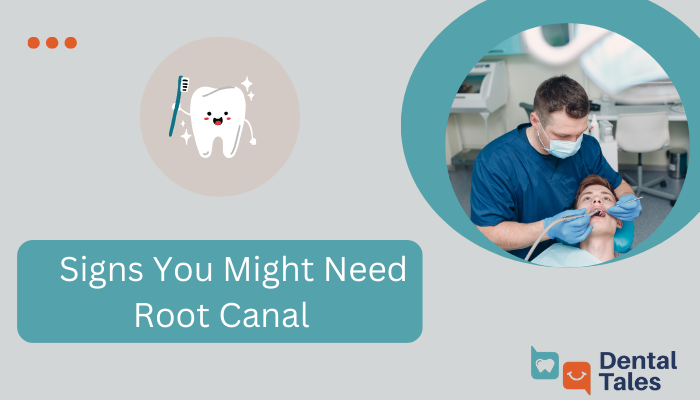As a certified and experienced dentist, I cannot stress enough the importance of recognizing the signs that may indicate the need for Root Canal Treatment. This procedure is vital for preserving oral health and preventing further complications. Understanding and identifying these signs early can significantly impact treatment success and overall dental well-being.
Recognizing the need for a root canal isn’t always straightforward. While certain symptoms, such as intense tooth pain or visible decay, clearly indicate that this procedure may be necessary, other indicators might not be as evident without a dentist’s expertise.
Often, significant symptoms don’t emerge until the condition has advanced, potentially leading to more extensive and expensive treatments like tooth extraction followed by tooth replacement. This underlines the significance of regular dental visits for early detection and prevention, possibly preventing root canals.

What Exactly is Root Canal Treatment (RCT)?
Root Canal Treatment involves removing the infected or damaged pulp inside a tooth. This dental procedure is crucial for saving a tooth that might otherwise need to be removed. It’s designed to eliminate pain and restore the tooth’s health.
The aim is to clean out the infected area and fill and seal the tooth, thereby stopping the infection and preventing it from spreading. There are some obvious signs that will indicate an RCT.
10 Signs that Tell You Need a Root Canal Treatment
1. Persistent Pain
Consistent toothache is one of the most important signs that you might need RCT. This discomfort can occur while chewing or when pressure is applied to the tooth. The intensity of the pain may vary, but it generally does not subside and can even worsen if left untreated. The pain might also persist at night, affecting your sleep.
2. Sensitivity to Hot and Cold Temperature
Experiencing sharp pain or prolonged sensitivity after consuming hot or cold foods and beverages is a common symptom. Unlike normal sensitivity, this discomfort persists even after the temperature stimulus is removed, which can suggest that a root canal is needed. Sensitivity not just to temperature but also to sweet foods can signal nerve damage and may be a sign you need this procedure.
3. Swollen and Tender Gums
Swelling and tenderness in the gums around a specific tooth can indicate an underlying infection. The presence of noticeable swelling, redness, tenderness, and bleeding gums clearly indicates something is wrong beneath the surface. Sometimes, the swelling may extend into the jaw and face.
4. Discoloration of the Tooth
Significant discoloration, especially a darkening or grayish tooth color, often indicates pulp damage. This color change is usually due to the pulp’s deterioration, signaling the need for treatment.
5. Pus or Abscess Formation
The presence of pus or an abscess on the gums near the affected tooth often signifies a severe infection. This situation requires immediate attention, as it not only causes pain and swelling but also causes a risk of spreading the infection.
6. Persistent Bad Breath
Chronic bad breath that doesn’t improve with regular brushing or flossing can be a sign of infected tooth pulp and may need a root canal. The infection can emit a foul odor, indicating something more serious than a typical bad breath.
7. Loose Tooth
If a tooth suddenly becomes loose without any apparent cause, such as trauma, it could be due to an infection. An infected tooth can become loose due to the acidic waste products of dead pulp tissues, weakening the bone that holds the tooth. This loosening is a sign that the health of the tooth’s pulp is compromised.
8. Bump on the Gums
A gum boil, or a pimple-like swelling on the gums, that recurs over time can indicate a persistent underlying infection. This symptom, often overlooked, should not be ignored as it points directly to the need for a root canal. This bump may ooze pus due to the infection and cause an unpleasant taste or bad breath.
9. Deep Decay
If the decay is present in the enamel and dentin, filling can be done to remove the cavity. But if the cavity is left untreated, the bacterial infection extends into the pulp. In this case, the infected tooth needs root canal treatment. Proper oral hygiene methods, like selecting the right toothbrush and toothpaste, brushing twice a day, flossing, and regular dental check-ups, can help minimize the risk of tooth decay.
10. Chipped or Cracked Tooth
A chipped or cracked tooth can often lead to the need for a root canal, especially if the damage extends into the tooth’s pulp. When a tooth is chipped or cracked, bacteria can invade and infect the pulp, the soft inner tissue of the tooth that contains nerves and blood vessels.
Why You Need to Take Root Canal Treatment on Time – Importance!
Ignoring these symptoms can lead to further complications, including spreading the infection to other areas of the mouth. Early detection and treatment are crucial. If you’re experiencing any of these symptoms, it’s essential to consult a dentist immediately.
Make sure you choose the right Endodontist for your Root Canal Treatment. In case you are not aware, an Endodontist is a dentist specializing in RCT.
Although the Root Canal procedure is considered painful, with today’s advanced techniques, most people report that the experience is no more uncomfortable than having a filling placed. The procedure not only relieves pain but also saves the tooth and restores its functionality, which is always a priority in dental care.
Conclusion:- Recognize Root Canal Signs, Protect Your Teeth
Root Canal Therapy is a vital procedure for preserving a tooth that might otherwise need to be removed. The importance of recognizing these signs cannot be overstated. As a dental health professional, I suggest you not ignore these symptoms. A thorough dental examination is the only definitive way to determine the need for a root canal. If you experience any of these symptoms, it’s crucial to consult with a dentist immediately. You can avoid RCT in the early stages of tooth decay by following proper oral hygiene methods like using the right toothbrush and toothpaste, brushing twice a day, and regular dental visits. Early detection and treatment are key to preserving teeth and maintaining optimal oral health. Remember, this treatment is not just about relieving pain—it’s about saving your tooth and ensuring your mouth remains healthy.
You can always book my appointment if you still have any questions or queries from here.
Frequently Asked Questions
A root canal is a dental procedure to treat infection or damage in a tooth’s pulp. During the procedure, the infected or damaged pulp is removed, and the inside of the tooth is cleaned, disinfected, and then filled and sealed.
Some signs that you might need a root canal include severe tooth pain, sensitivity to hot or cold, swelling of the gums, a pimple-like bump on the gums, or darkening of the tooth.
Alternatives to root canal therapy include tooth extraction followed by replacement options such as dental implants, bridges, or removable partial dentures.
While some general dentists perform root canals, you may be referred to an endodontist, a dentist specializing in root canal therapy.

